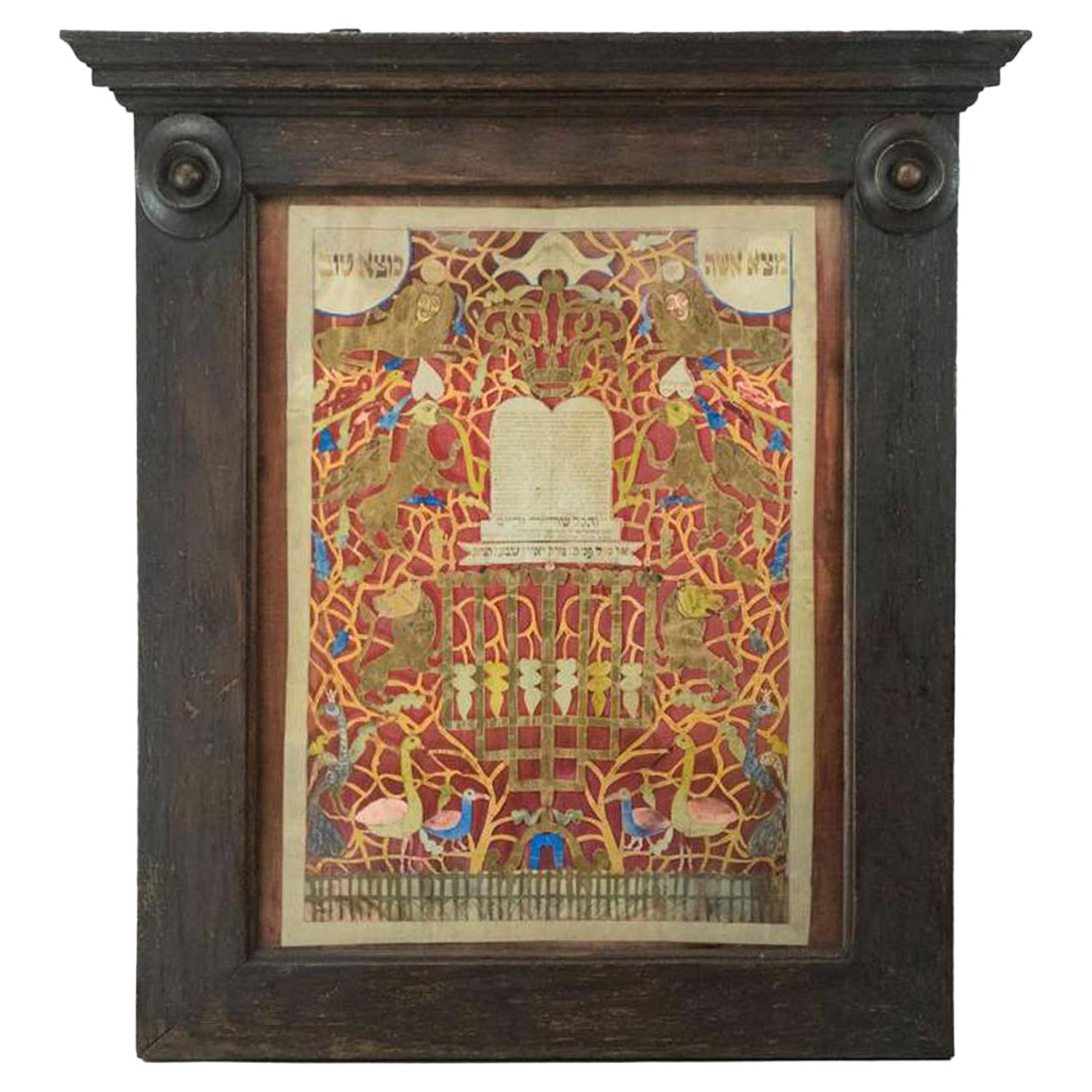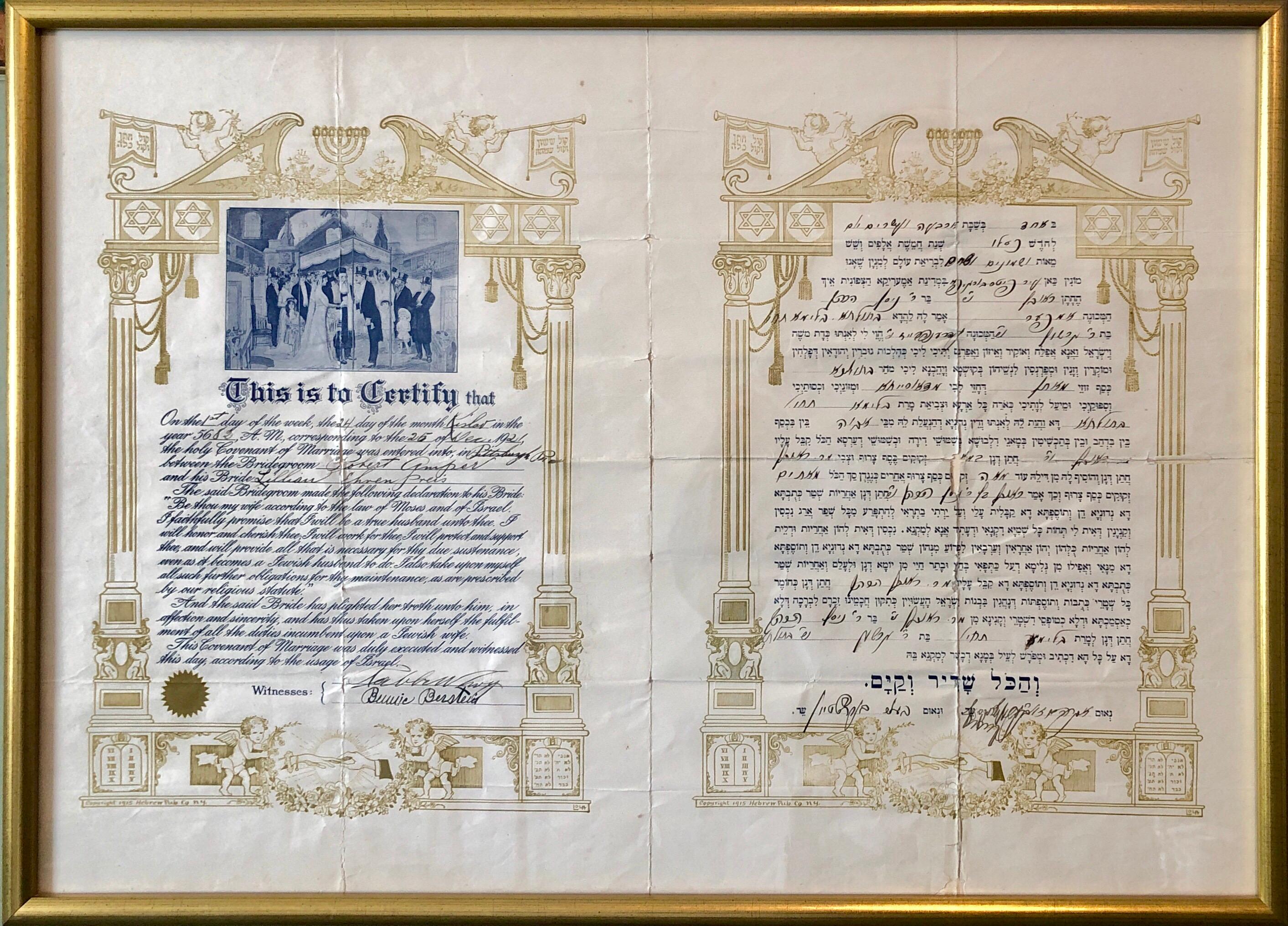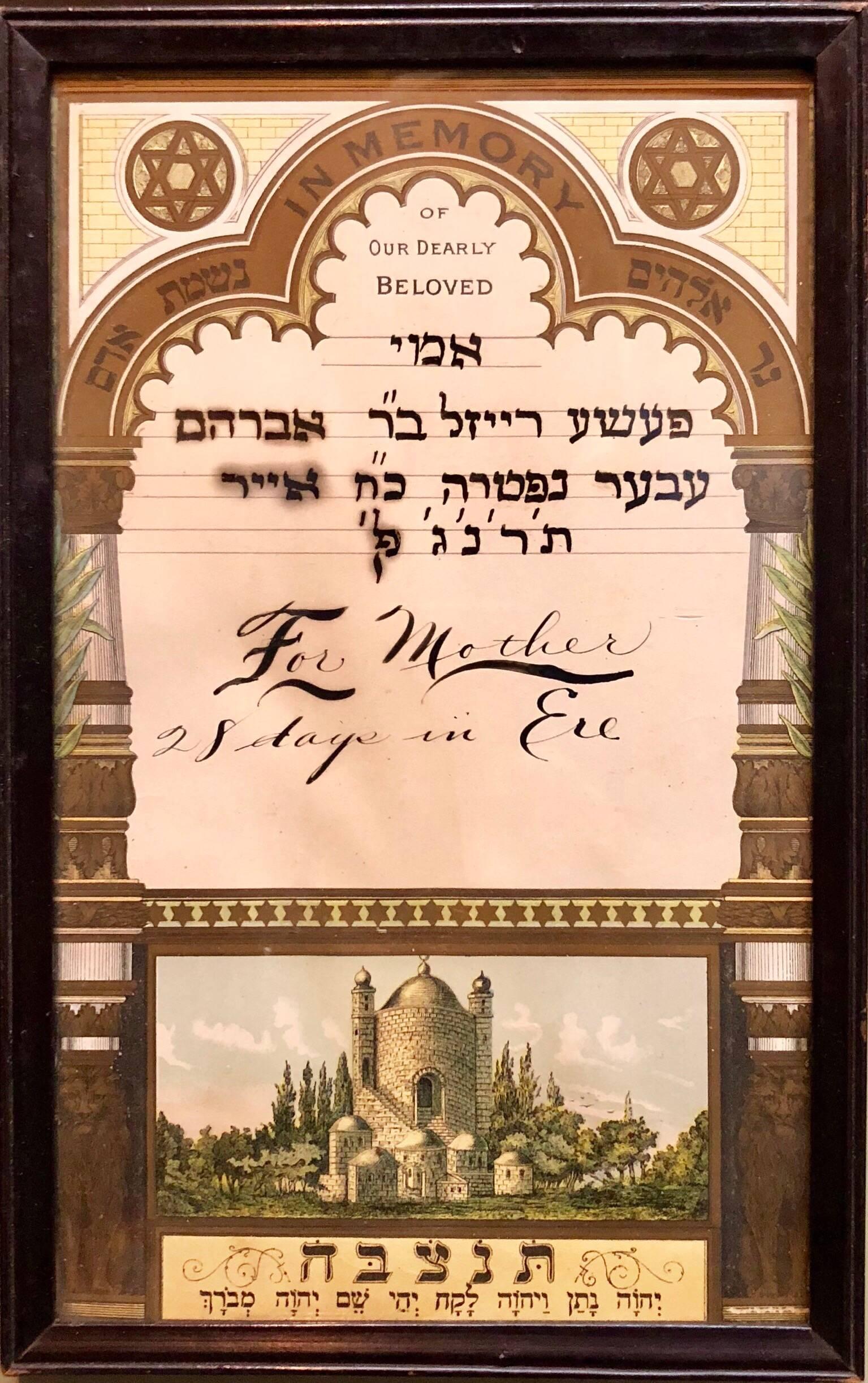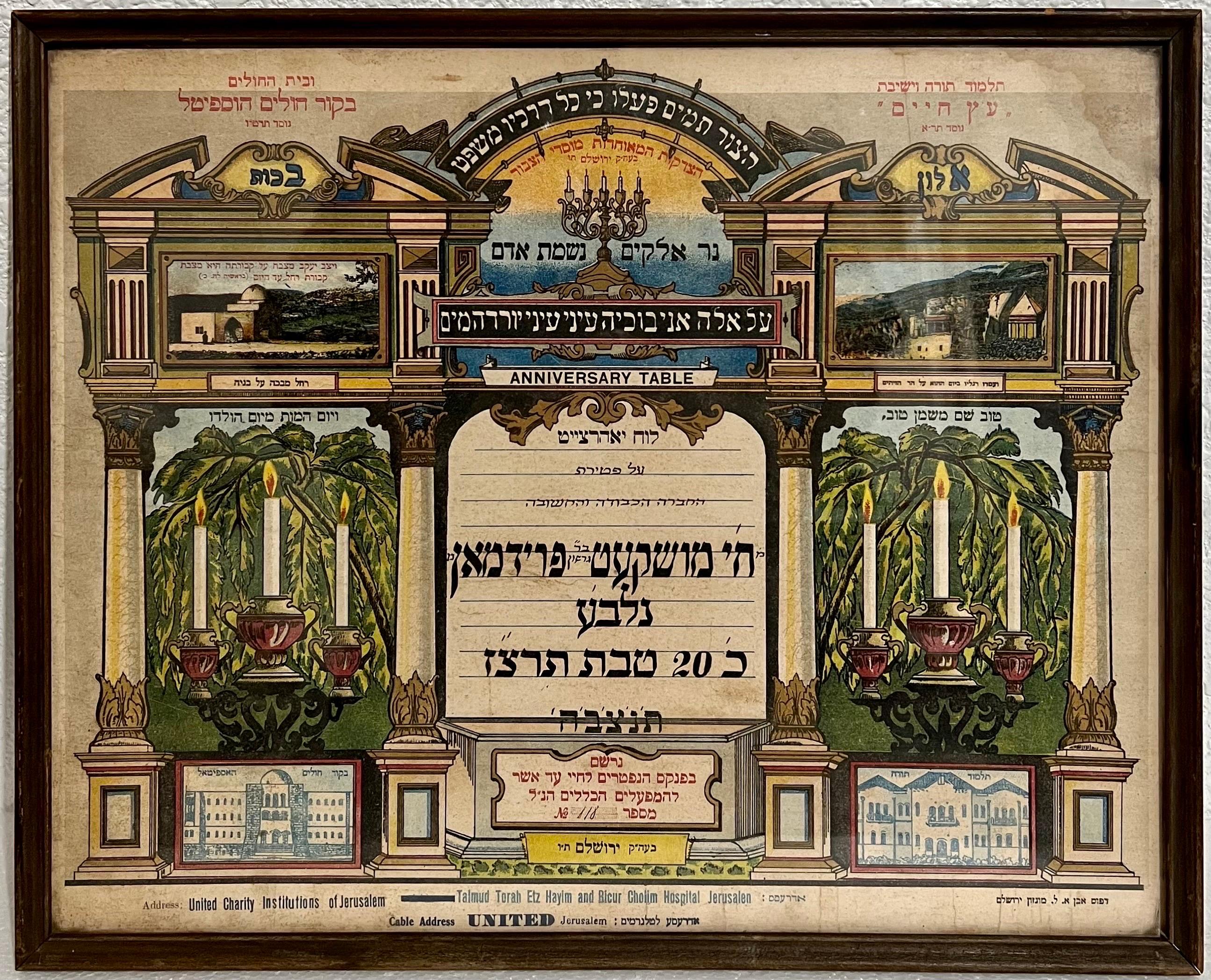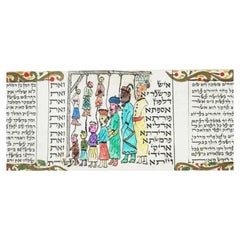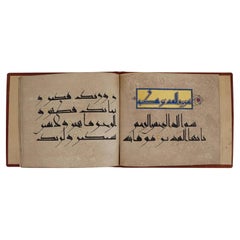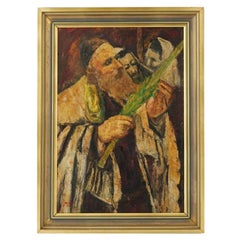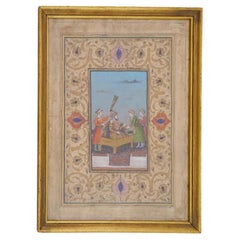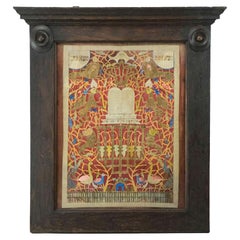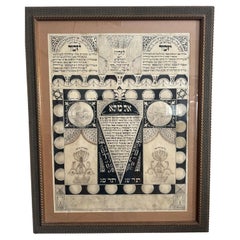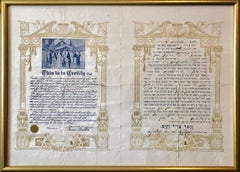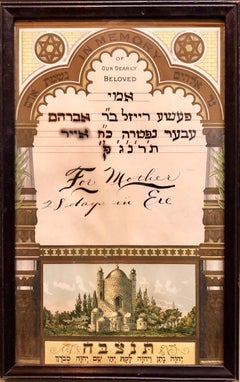Items Similar to 1840S PERSIA Isfahan JUDAICA ILLUMINATED MARRIAGE CONTRACT Ketubah
Want more images or videos?
Request additional images or videos from the seller
1 of 7
1840S PERSIA Isfahan JUDAICA ILLUMINATED MARRIAGE CONTRACT Ketubah
$3,500
£2,655.72
€3,036.58
CA$4,888.55
A$5,435.40
CHF 2,838.07
MX$66,162.10
NOK 36,212.51
SEK 33,929.39
DKK 22,662.54
Shipping
Retrieving quote...The 1stDibs Promise:
Authenticity Guarantee,
Money-Back Guarantee,
24-Hour Cancellation
About the Item
A Jewish Ketubah, or marriage contract. Isfahan, Persia, Qajar Empire, ca. 1840s. Hand-written document with colored illustrations, including lion and sun, the Imperial symbols of power, as well as flowers and birds. Framed. Collectible Judaica, Papers And Documents, Graphic Art.
Dimensions: Frame 31 1/2 x 30 in. Image 27 x 25 in. All measurements are approximate.
Condition
Overall good vintage condition. Signs of wear and age. Folding mark. Refer to photos.
- Dimensions:Height: 30 in (76.2 cm)Width: 31.5 in (80.01 cm)Depth: 3 in (7.62 cm)
- Materials and Techniques:
- Place of Origin:
- Period:
- Date of Manufacture:1840s
- Condition:Wear consistent with age and use.
- Seller Location:Long Island City, NY
- Reference Number:1stDibs: LU7386246004252
About the Seller
4.9
Platinum Seller
Premium sellers with a 4.7+ rating and 24-hour response times
1stDibs seller since 2022
96 sales on 1stDibs
Typical response time: <1 hour
- ShippingRetrieving quote...Shipping from: Long Island City, NY
- Return Policy
Authenticity Guarantee
In the unlikely event there’s an issue with an item’s authenticity, contact us within 1 year for a full refund. DetailsMoney-Back Guarantee
If your item is not as described, is damaged in transit, or does not arrive, contact us within 7 days for a full refund. Details24-Hour Cancellation
You have a 24-hour grace period in which to reconsider your purchase, with no questions asked.Vetted Professional Sellers
Our world-class sellers must adhere to strict standards for service and quality, maintaining the integrity of our listings.Price-Match Guarantee
If you find that a seller listed the same item for a lower price elsewhere, we’ll match it.Trusted Global Delivery
Our best-in-class carrier network provides specialized shipping options worldwide, including custom delivery.More From This Seller
View AllAntique Judaica Hand Illuminated Megillah Scroll of Esther Manuscript
Located in Long Island City, NY
An antique Megillah The Book of Esther, hand written on parchment by an expert Sephardi scribe and richly decorated with hand painted illustrations. The text panels are surrounded by...
Category
Antique 19th Century Unknown Drawings
Materials
Parchment Paper
Early 20Th C Hand Written Quran Surah Manuscript
Located in Long Island City, NY
A museum quality hand written Quran Surah manuscript in Kufic script. Circa the first half of the 20th century. Religious Books And Home Library Specimen For Collectors.
Dimensions: ...
Category
Early 20th Century Unknown Religious Items
Materials
Paper
Judaica Portrait Oil Painting of a Rabbi Examining the Lulav Signed Rosendall
Located in Long Island City, NY
An oil painting on canvas representing a Judaica portrait of an old Rabbi, after the original oil painting, Examining the Lulav, . Signed by the artist, Rosendall, lower left. Framed...
Category
Antique 19th Century Unknown Paintings
Materials
Paint
$1,250 Sale Price
50% Off
Antique Indian Mughal Empire Miniature Painting
Located in Long Island City, NY
An antique Indian Mughal Empire miniature painting executed in gouache and embellished with gold on paper, portrays a captivating court scene wherein a ruler engages with nobles. The...
Category
Antique Early 19th Century Unknown Paintings
Materials
Paint
Large Antique Persian Iranian Safavid Textile
Located in Long Island City, NY
A large antique Persian Iranian Safavid dynasty hand woven textile blanket. The textile decorated with floral ornaments in warm tones. Circa 17th century. The Safavid dynasty, which ...
Category
Antique 17th Century Unknown Textiles
Materials
Textile
$1,800 Sale Price
40% Off
Antique Indo Persian Mixed Media Miniature Painting
Located in Long Island City, NY
An antique Indo Persian Mughal Art mixed media miniature painting on paper depicting a courtyard scene with Deity probably Vishnu painted in bold colors and with fine details, and gi...
Category
Antique 19th Century Unknown Paintings
Materials
Paint
You May Also Like
Early 20th Century Eastern European Paper Cut Ketubah, Jewish Marriage Contract
Located in New York, NY
An Eastern European Kethubah Strikingly Decorated in Papercut Form, and with the Central Traditional Hebrew Text of a Most Uncommon Petite Appearance.
Uni...
Category
Antique Early 1900s European Religious Items
Materials
Paper
$15,600 Sale Price
20% Off
Hungarian Yizkor and El Male Rachamim Memorial Prayer Scroll, 1903
Located in New York, NY
This finely crafted ink-on-paper manuscript from 1903 features the Yizkor and El Male Rachamim prayers, traditional Jewish memorial prayers recited for the souls of the deceased. The...
Category
Early 20th Century Hungarian Religious Items
Materials
Paper
Rare 1915 Early 20c Century Ketubah Hand Written Text NYC Hebrew Publishing co.
Located in Surfside, FL
Vintage Jewish marriage contract, Most likely printed in the USA or Germany. Used in Pittsburgh, Pennsylvania, hand dated 1921. A rare early American judaic piece. Printed in gold an...
Category
Early 20th Century Gothic More Art
Materials
Paper, Ink
Rare Judaica 1893 Jewish Yizkor Memorial Plaque Hebrew English Chromolithograph
Located in Surfside, FL
A rare Judaic memorial piece for mother.
Category
Late 19th Century Aesthetic Movement More Prints
Materials
Lithograph
Rare Palestine Antique Hebrew Judaica Yahrzeit Synagogue Sign Memorial Plaque
Located in Surfside, FL
Circa 1890-1920. This Neoclassical, Judaic, Egyptian revival, Orientalist Mizrach sign, was produced in British Mandate Palestine by the chromolithograph process at the beginning of the 20th century. It pictures vignettes of holy places. with a hand written memorial. It was for the Tzedakah charity fund for the century-old institutions in Jerusalem: The great "Torah Center Etz Chaim"; a Free Kitchen for poor children and orphans; the famous Bikur Cholim Hospital with its dispensaries and clinics and the only Home for Incurable Invalids in Eretz Israel. They also worked with Arthur Szyk and Alfred Salzmann.. The A.L. Monsohn Lithographic Press (Monzon Press, Monson Press, דפוס אבן א"ל מאנזאהן, דפוס מונזון) was established in Jerusalem in 1892 by Abraham-Leib (or Avrom-Leyb) Monsohn II (Jerusalem, c.1871-1930) and his brother Moshe-Mordechai (Meyshe-Mordkhe). Sponsored by members of the Hamburger family, the brothers had been sent to Frankfurt, Germany in 1890 to study lithography. Upon returning to Jerusalem in 1892 with a hand press, they established the A.L. Monsohn Lithographic Press in the Old City of Jerusalem. According to the Information Center for Israeli Art A.L. Monsohn "created complex decorations for documents and oriental calendars that combined the tradition of Jewish art with modern printing techniques such as photographic lithography, raised printing and gilding."
The founders of the Monsohn press produced Jewish-themed color postcards, greeting cards, Jewish National Fund stamps, and maps documenting the evolution of the Jewish settlement in Eretz Israel in the nineteenth-twentieth centuries; religious material such as decorative plaques for synagogues, portraits of Old Yishuv rabbis such as Shmuel Salant, Mizrah posters indicating the direction of prayer for synagogues, memorial posters, and posters for Sukkot booths; color frontispieces for books such as Pentateuch volumes and the early song collections of Abraham Zvi Idelsohn (e.g., Shire Zion, Jerusalem 1908); artistic wedding invitations; and labels, packaging and advertisements for the pioneering entrepreneurs of Eretz Israel. The texts appearing in the Monsohn products were in several languages: Hebrew, Arabic, Yiddish, English, German (e.g., a c1920 trilingual Hebrew-English-Arabic "Malaria Danger" broadside warning the public of mosquitoes spreading malaria). Many of the brilliantly colored postcards and maps can be seen online as can the artistic invitations to his children's weddings which Monsohn published in the Jerusalem Hebrew press.
For years, the Monsohn (later, Monson/Monzon) Press was considered the best and most innovative in the country—pioneering in such techniques as gold-embossing and offset printing, among others. Early items for tourists included collections of Flowers of the Holy Land (c. 1910–1918)—pressed local flowers accompanied by scenes from the Eretz Israel countryside and relevant verses from the Bible, edited by Jsac Chagise (or Itzhak Haggis), an immigrant from Vitebsk, and bound in carved olive wood boards. Shortly after World War I Monsohn (now spelled מונזון) used zincography to produce the prints included in the Hebrew Gannenu educational booklets for young children illustrated by Ze'ev Raban of the Bezalel Academy of Art and Design and printed in Jerusalem by Hayim Refael Hakohen (vol. 1, 1919; vols. 2–3, 1920). In 1934 Monsohn moved into the new, western part of Jerusalem, in a shop with four presses and 30 workers, including Abraham-Leib's sons, David, Yosef, Moshe and Shimon, and his daughter Raytse's husband, Abraham Barmacz. The concern did business with all sectors of the city's population, including Arabs, for whom they printed in Arabic. Among their clients were members of the Ginio, Havilio, and Elite families, and Shemen, Dubek, and other renowned national brands, manufacturing products such as wine, candies, oil, and cigarettes. They also printed movie and travel posters, and government posters, postcards and documents, hotel luggage labels...
Category
Early 20th Century Aesthetic Movement More Art
Materials
Lithograph
Vintage Judaica Tapestry, "Rachel Imenu" 10 Commandments, Stars of David, 1930
Located in Lomita, CA
This vintage Judaica tapestry has a bit of Hollywood history. It was framed and sold on Melrose avenue during the 1960s by the actress who played the ...
Category
Early 20th Century Israeli Other Tapestries
Materials
Fabric

